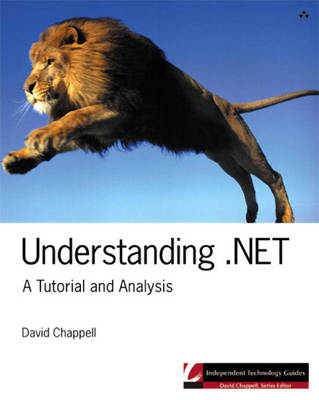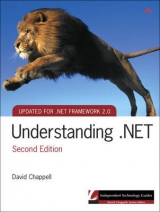
Understanding .NET
Addison Wesley (Verlag)
978-0-201-74162-9 (ISBN)
- Titel erscheint in neuer Auflage
- Artikel merken
Understanding .NET: A Tutorial and Analysis is a concise guide to the new landscape of Windows development. Margin notes, detailed diagrams, and lucid writing make this book easy to navigate and to read, while analysis sections explore controversial issues and address common concerns. The book's independent perspective and straightforward descriptions make clear both how the .NET technologies work and how they can be used.
David Chappell is Principal of Chappell & Associates and the best-selling author of Understanding ActiveX and OLE (Microsoft Press) and other books. Through his speaking, writing, and consulting, David helps information technology professionals around the world understand, use, and make better decisions about new technologies.
Preface.
1. An Overview of .NET.
Defining .NET.
Web Services.
The .NET Framework.
The Common Language Runtime.
CLR-Based Languages.
The .NET Framework Class Library.
The .NET Compact Framework.
.NET My Services.
The .NET Enterprise Servers.
A .NET Scenario.
Conclusion.
2. Web Services.
Describing Web Services.
Applying Web Services.
Access to Internet Applications.
B2B Integration.
A2A Integration.
A Web Services Scenario.
Web Services Technologies.
Describing Information: XML.
Defining Web Services: WSDL.
Accessing Web Services: SOAP.
Finding Web Services: UDDI.
Future Directions for Web Services.
Conclusion.
3. The Common Language Runtime.
Building Managed Code: The Common Type System.
Introducing the Common Type System.
A Closer Look at CTS Types.
The Common Language Specification.
Compiling Managed Code.
Microsoft Intermediate Language (MSIL).
Metadata.
Organizing Managed Code: Assemblies.
Metadata for Assemblies: Manifests.
Categorizing Assemblies.
Executing Managed Code.
Loading Assemblies.
Compiling MSIL.
Securing Assemblies.
Garbage Collection.
Application Domains.
Conclusion.
4. .NET Languages.
C#.
A C# Example.
C# Types.
C# Control Structures.
Other C# Features.
Visual Basic.NET.
A VB.NET Example.
VB.NET Types.
VB.NET Control Structures.
Other VB.NET Features.
C++ with Managed Extensions.
A Managed C++ Example.
Managed C++ Types.
Other Managed C++ Features.
Conclusion.
5. The .NET Framework Class Library.
An Overview of the .NET Framework Class Library.
The System Namespace.
A Survey of System's Subordinate Namespaces.
Input and Output: System.IO.
Serialization: System.Runtime.Serialization.
Working with XML: System.Xml.
The XML Technology Family.
What System.Xml Provides.
Reflection: System.Reflection.
.NET Remoting: System.Runtime.Remoting.
An Overview of the Remoting Process.
Passing Information to Remote Objects.
Choosing a Channel.
Creating and Destroying Remote Objects.
Enterprise Services: System.EnterpriseServices.
Interoperability: System.Runtime.InteropServices.
Accessing COM Objects.
Accessing Non-COM DLLs.
Windows GUIs: System.Windows.Forms.
Building GUIs Using Windows Forms.
Windows Forms Controls.
Conclusion.
6. Accessing Data: ADO.NET.
.NET Data Providers.
Direct Access to Data.
Accessing Data with DataSets.
Creating and Using DataSets.
Accessing and Modifying a DataSet's Contents.
Using DataSets with XML-Defined Data.
Conclusion.
7. Building Web Applications: ASP.NET.
Browser Applications: System.Web.UI.
How Browser Applications Work.
Web Controls.
Separating the User Interface from the Code.
Other Topics.
Web Services Applications: System.Web.Services.
Web Services Servers.
Web Services Clients.
Options for Web Services Applications.
Microsoft-Specific Support for Web Services Applications.
Conclusion.
8. .NET My Services.
Defining .NET My Services.
Applying .NET My Services.
Assuring Privacy.
The .NET My Services Business Model: Software as a Service.
Describing .NET My Services.
The Authentication Service: Passport.
XML-Based Services.
A .NET My Services Scenario.
Conclusion.
About the Author.
Index. 0201741628T01162002
| Erscheint lt. Verlag | 26.2.2002 |
|---|---|
| Verlagsort | Boston |
| Sprache | englisch |
| Maße | 186 x 234 mm |
| Gewicht | 626 g |
| Themenwelt | Mathematik / Informatik ► Informatik ► Netzwerke |
| Mathematik / Informatik ► Informatik ► Web / Internet | |
| ISBN-10 | 0-201-74162-8 / 0201741628 |
| ISBN-13 | 978-0-201-74162-9 / 9780201741629 |
| Zustand | Neuware |
| Haben Sie eine Frage zum Produkt? |
aus dem Bereich



